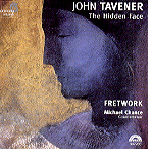The disc cover would have us believe that this is a John Tavener program when in fact it’s really a Fretwork recording (its first for Harmonia Mundi) that happens to include three Tavener pieces (out of a total of eight selections). The majority of the disc features 16th and 17th century works for viols (the Purcell is arranged for viols and countertenor) and not coincidentally offers a famous composition by 16th-century master John Taverner (the one with an “r”). I suppose you can’t blame either performers or label for exploiting the name of one of today’s more faddish composers, but ironically, the inclusion of Tavener’s music alongside the works of his illustrious predecessors–particularly Purcell and Taverner–only serves to highlight the shocking vacuity of his so-called art. Really, this is becoming insulting to the intelligence and integrity of millions of listeners who know better than to gorge on a plate of already-chewed-up musical mush just because it comes with a label marked with fancy Greek letters or a seal of certification from the composer’s cult of “mystical” followers.
Fundamentally, the program’s big work, The Hidden Face, scored for countertenor, oboe, and six viols, is an aimless mess–chords, chords, and more slow-moving chords, a startling, squawking oboe, an intrepid, undaunted, wandering countertenor, all washing around in a big soup: cream of nowhere. Can you find a point in all of this? Oh yes, Tavener always has an explanation. And that’s the problem: you always have to read about what the music is supposed to mean before you can “appreciate” its deep, mystical message. Nonsense. And we’re asked to get all excited about another work, Apokatástasis, written “at the last minute” for this very recording. Better it fell into a trash can for all its value as sensible, meaningful music. This time the countertenor squawks (not his fault)–up and down a narrow scale, to the “tune” of bonking Tibetan bowls and viols struggling to add some sort of rationality to the proceedings. Once more, nothing happens, albeit with lots of feeling.
Tavener’s Nipson, the piece that according to Fretwork member Richard Campbell was the “germ of this disc”, actually has some really lovely moments of melody and harmony–offering a semblance of listenable if totally derivative sound reminiscent of earlier styles in its scoring for countertenor and five viols. But again, it just goes curling off into oblivion–more than 20-minutes’-worth, formless and without discernible purpose. Is this some kind of penance? Well, as a matter of fact it is, according to the notes: “Nipson is an ikon of glory and repentance. . .inner silence present throughout, as the composer contemplates his sins. . .” Sins indeed. As for me, I’d rather enjoy the beauty of music and of Michael Chance’s impressive vocalism in Purcell’s An Evening Hymn, or the skillfully wrought lines and taut structure of the Sanctus & Benedictus from Taverner’s Gloria tibi Trinitas mass, transcribed here for six viols. There’s a reason why that music has held up for hundreds of years; and while we live in an age where the lines between honesty and pretense, and between art and commerce are routinely and shamelessly blurred, time ultimately will be the judge of Tavener’s creations as well. Meanwhile, don’t let someone else tell you what to think: listen for yourself.
































